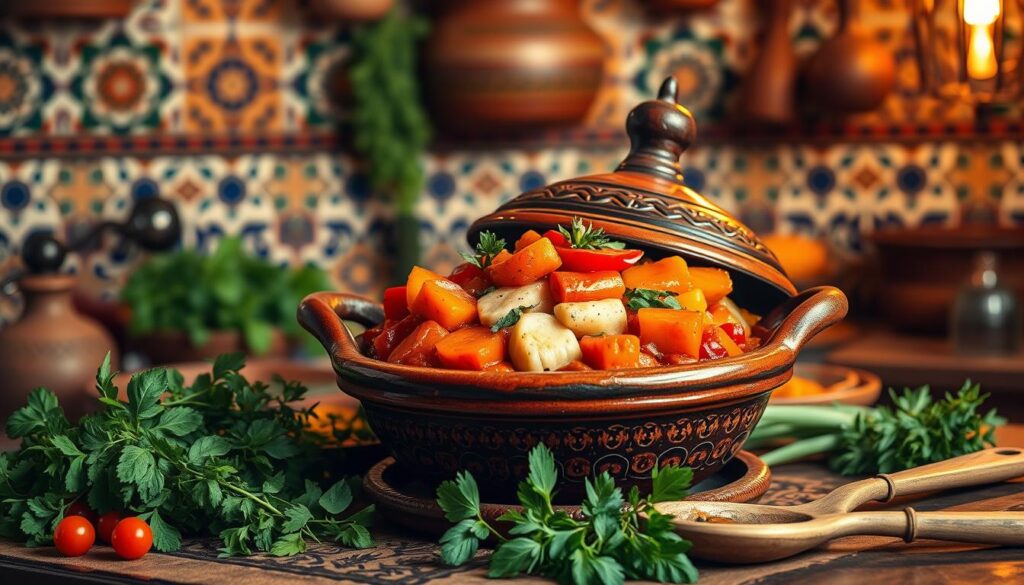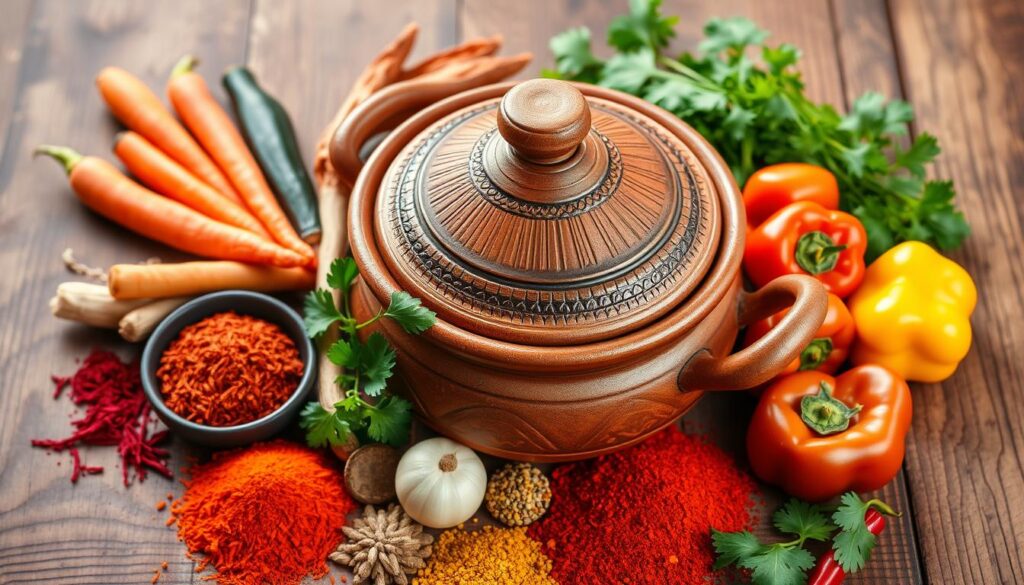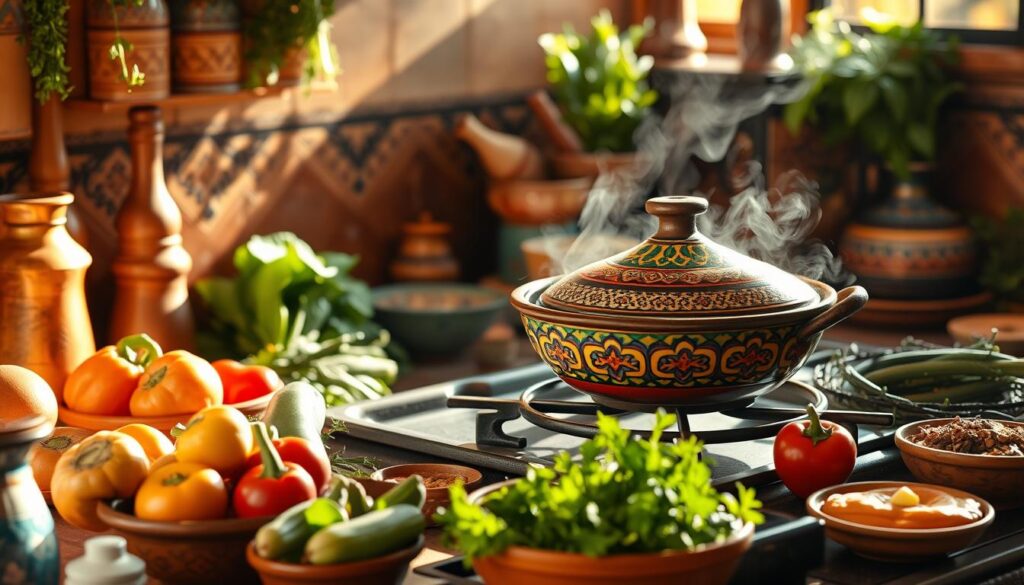Welcome to the world of Moroccan cuisine. Here, the traditional art of tajine cooking brings people together. This guide will help you learn about Moroccan dishes and make authentic tajine recipes at home. With just five easy steps, you’ll discover the secrets of this iconic cooking method.
It focuses on aromatic spices and fresh ingredients that define Moroccan flavors. Get ready for a culinary adventure. You’ll learn cooking tips that will make your dishes and cooking experience better.

Key Takeaways
- Discover the cultural significance of tajine in Moroccan cuisine.
- Learn essential cooking tips for authentic tajine recipes.
- Explore the unique features and benefits of tajine cookware.
- Identify key ingredients for creating traditional Moroccan dishes.
- Follow a step-by-step guide to cooking delicious tajine.
- Get inspired by popular tajine dishes you can try at home.
Introduction to Moroccan Tajine Cooking
Moroccan food is loved all over the world for its deep flavors and lively scents. Tajine cooking is a key part of this tradition. The tajine, a traditional clay pot, is the heart of making many tasty dishes.
This cooking method shows the importance of sharing meals in Moroccan culture. Families and friends come together to enjoy a meal. They share stories and the history of the food they’re eating.
The slow-cooking process in tajine cooking brings out the best flavors. Ingredients like preserved lemons, olives, and herbs make each dish special. This makes tajine cooking a beloved art form.
The Unique Features of Tajine Cookware
Tajine cookware is a key part of Moroccan cooking. It has a special shape with a conical lid. This design helps in trapping heat and moisture, making slow cooking efficient.
This slow cooking is a big part of Moroccan food. Knowing about these features helps us appreciate this beautiful Moroccan pottery.
What is a Tajine?
A tajine is a traditional cooking pot made from earthenware. It has a shallow base and a tall, conical lid. This shape helps spread heat evenly, perfect for slow-cooked dishes.
The slow cooking process blends flavors together. This makes meals aromatic and rich. You can cook many dishes in a tajine, like meats, veggies, and even desserts. It’s very versatile in the kitchen.
Benefits of Using Tajine Cookware
Using tajine cookware has many benefits for healthy cooking. It retains heat well, so you don’t need a lot of fat or oil. This makes meals healthier.
The slow cooking also keeps nutrients in the food. It makes ingredients taste better and become tender. Plus, you can add aromatic spices, which are a big part of Moroccan cooking.
Key Ingredients for Authentic Tajine Recipes
Making authentic tajine dishes starts with the right ingredients. Moroccan spices are key to great taste. High-quality meats and vegetables add to these flavors. Here’s what you need for your next tajine.
Essential Spices in Moroccan Cuisine
Spices are the heart of Moroccan cooking. They add depth and complexity. Here are the must-have spices for your tajine:
- Cumin – Adds a warm and earthy flavor.
- Coriander – Brings a light, citrusy taste.
- Turmeric – Provides a vibrant color and subtle warmth.
- Cinnamon – Introduces a sweet note, often paired with meats.
- Saffron – Infuses a luxurious flavor and beautiful hue.
Choosing the Right Meats and Vegetables
The right meats and vegetables are crucial for a great tajine. Fresh, high-quality ingredients make the meal better. Here’s what to choose:
- Lamb – A popular choice, delivering rich and tender bites.
- Chicken – Versatile and absorbs flavors well.
- Seasonal Vegetables – Opt for fresh options like carrots, potatoes, and zucchini for varying textures and tastes.
When picking your ingredients, go for local markets or trusted vendors. This ensures freshness. It makes your tajine truly authentic.

How to Cook Tajine: Step-by-Step Guide
Cooking tajine is an art that combines flavors and textures into a single, delightful dish. This guide will lead you through the process of preparing a delicious tajine. Follow these steps for the best results.
1. Preparation: Start by marinating your choice of meat, such as chicken or lamb. Use spices like cumin, paprika, and coriander to add depth. Let the meat marinate for at least an hour; overnight is best for tenderness.
2. Chopping Vegetables: While the meat marinates, chop vegetables like carrots, potatoes, and bell peppers. These add texture and nutrition. Make sure the pieces are uniform for even cooking.
3. Layering in the Tajine: Place the marinated meat at the bottom of your tajine. Add vegetables on top for color and nutrition. You can also add dried fruits like apricots or prunes for sweetness.
4. Cooking Process: Cover the tajine and cook on low to medium heat. Cooking slowly allows flavors to meld. Cooking time varies from 1.5 to 3 hours. Use a gentle simmer to avoid burning.
5. Serving: Once cooked, remove the tajine from heat. Serve directly from the pot. Enjoy with couscous or crusty bread to soak up the sauce.
Here is a quick overview of the cooking times and temperatures:
| Step | Action | Cooking Time | Heat Level |
|---|---|---|---|
| 1 | Marinate meat | 1 hour to overnight | N/A |
| 2 | Chop vegetables | 10-15 minutes | N/A |
| 3 | Layer ingredients in tajine | 5 minutes | N/A |
| 4 | Cook | 1.5 to 3 hours | Low to Medium |
| 5 | Serve | Immediately | N/A |

Customizing your tajine to fit your tastes is encouraged. Try different meats and vegetables to find your favorite version of this classic dish.
Popular Tajine Dishes to Try
Exploring traditional tajine recipes opens a world of flavors. One favorite is Chicken Tajine with Preserved Lemons and Olives. It combines the tangy taste of preserved lemons with tender chicken. This mix creates a perfect balance of savory and citrusy flavors.
The olives add a briny touch, making it a beloved dish in Morocco.
Lamb Tajine with Apricots is another hit. It features lamb cooked with sweet apricots and spices. This results in a comforting dish that shows the sweet and savory sides of Moroccan food.
This dish also reflects Morocco’s cultural traditions and celebrations.
For a vegetarian choice, try the Vegetable Tajine with Couscous. It’s full of seasonal veggies and spices. Served with fluffy couscous, it’s a hearty and fulfilling meal.
Each bite brings a taste of Moroccan culture. It inspires you to make your own version at home.
FAQ
What is Moroccan Tajine?
Moroccan Tajine is a slow-cooked stew. It’s made with meats, vegetables, and spices. The dish is cooked in a special earthenware pot with a conical lid.
What are the essential spices in Moroccan cuisine?
Key spices in Moroccan cooking are cumin, coriander, turmeric, cinnamon, and saffron. These spices give tajine its rich flavors.
Can I use a slow cooker instead of traditional tajine cookware?
You can use a slow cooker, but traditional tajine pots are better. They keep heat and moisture in, making the dish more authentic.
What types of meat work best in tajine recipes?
Lamb, chicken, and beef are common in tajine. Each meat adds a unique taste. Choose fresh, high-quality cuts for the best flavor.
How do I select the right vegetables for my tajine?
Pick fresh, seasonal veggies that go well with your meat. Carrots, potatoes, zucchini, and chickpeas are good choices. Mixing veggies adds color and flavor.
Are there vegetarian tajine options?
Yes, there are many tasty vegetarian tajine recipes. You can use veggies, legumes, and grains like couscous or chickpeas and spinach.
What is the significance of tajine cooking in Moroccan culture?
Tajine cooking is a big part of Moroccan culture. It’s a dish shared with family and friends, showing hospitality and togetherness.
How long does it take to cook a perfect tajine?
Cooking a tajine takes 1.5 to 2.5 hours. The slow cooking makes the meat tender and the flavors deep.
Can I modify tajine recipes according to my dietary preferences?
Yes, you can! Tajine recipes can be changed to fit your diet. You can swap ingredients, use different proteins, or try new spices.
